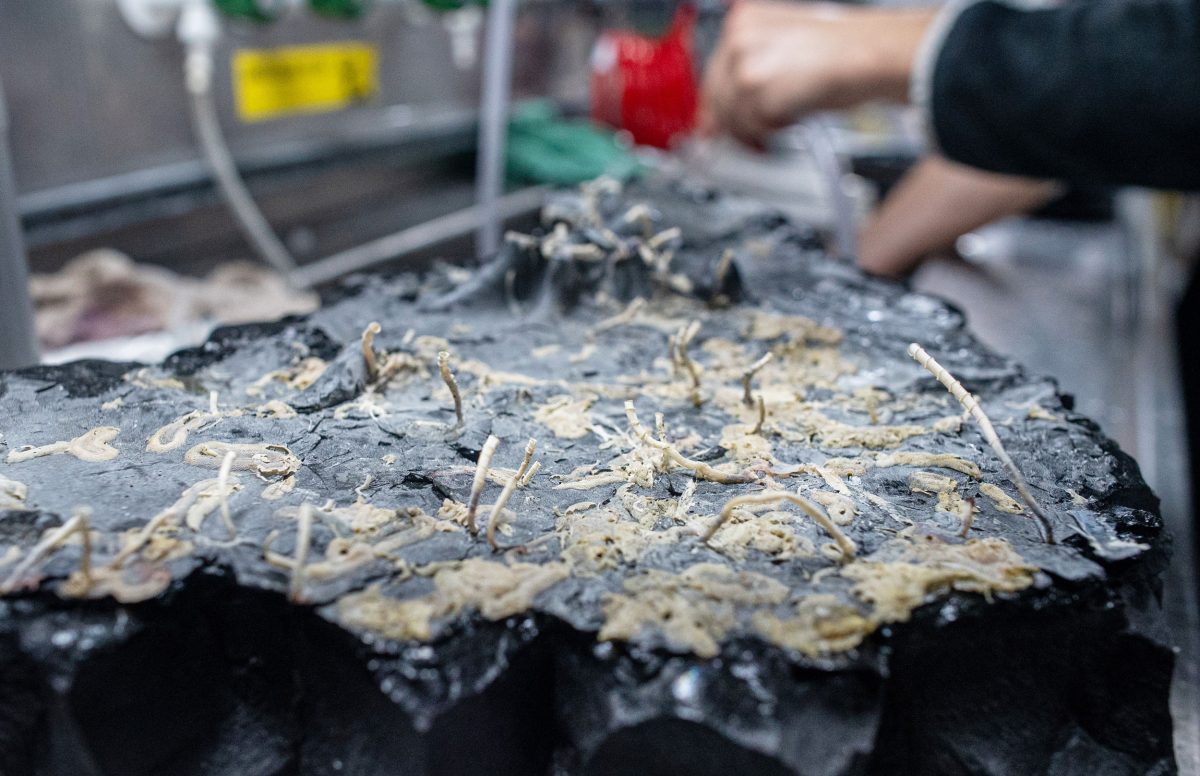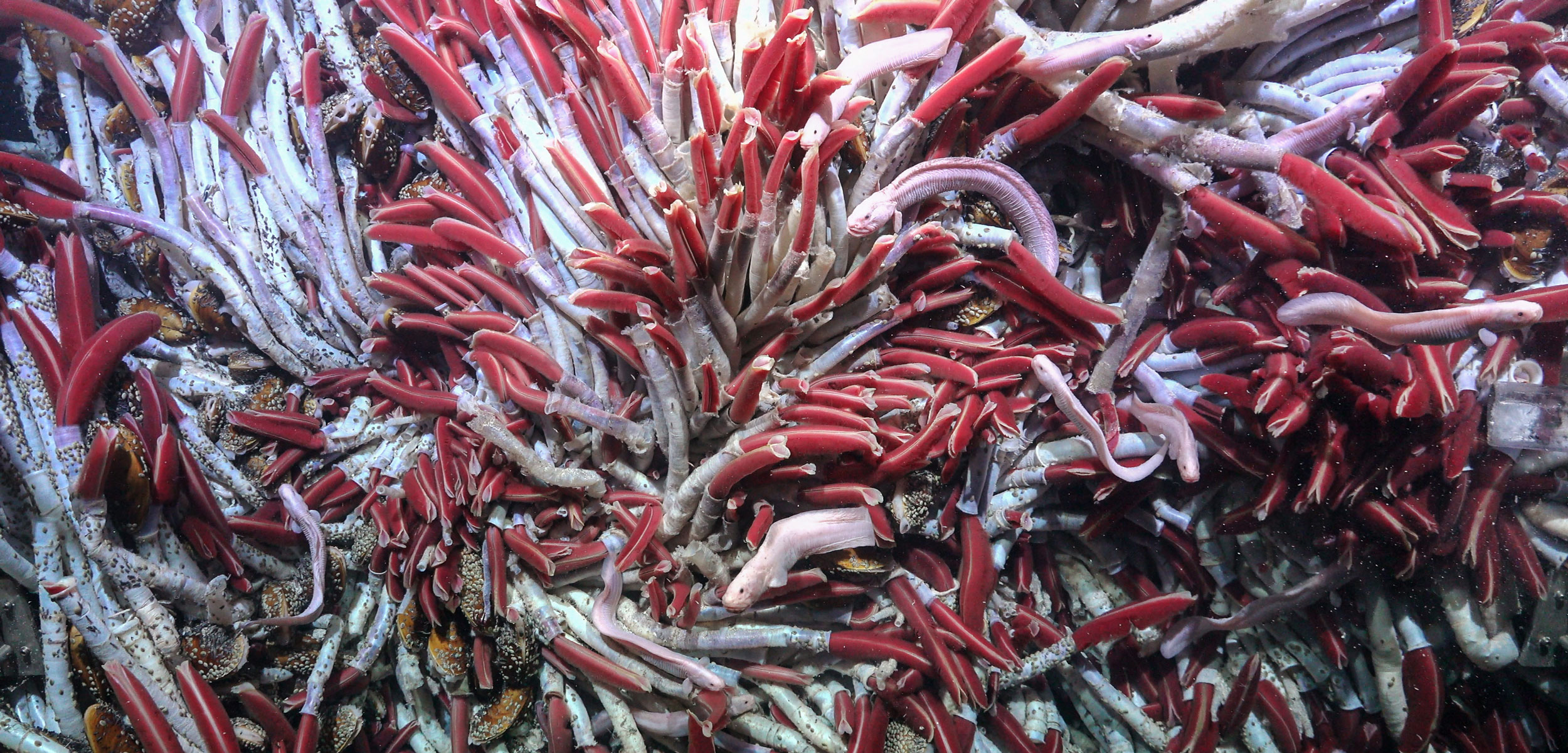Scientists Discover a Labyrinth of Life Hidden in the Deep
A deep-sea expedition in Central America uncovers symbiotic bacteria and tube worm nurseries thriving below the seafloor.
Article body copy
This story was originally published by Scientific American and is reproduced here with permission.
There may be no ecosystem on Earth that seems less hospitable than hydrothermal vents. In the perpetual darkness, cold, and relentless pressures of the deep sea, these volcanic seeps spew piping hot water so loaded with particles and metals that it looks like black smoke billowing from a chimney. But even these hellish habitats are crawling with life, ranging from giant clams and ravenous crabs to spindly octopuses and ghostly eelpout fish.
And those are just the creatures lurking above the vents. Using a deep-sea remotely operated vehicle (ROV), researchers recently flipped over slabs of seafloor to uncover a hidden ecosystem teeming with tiny life beneath the vents themselves. According to Monika Bright, a zoologist at the University of Vienna in Austria who led the expedition, the assortment of worms, snails, and microscopic larvae and bacteria that reside down here adds a new layer of complexity to hydrothermal vent ecosystems, which scientists have studied since 1977.
“We’ve known about the vents above for a long time, but this is basically a completely new ecosystem below,” Bright says. “It’s especially strange that we found it in a place that is very well studied.”
Last month, Bright and an international team of collaborators boarded the nonprofit Schmidt Ocean Institute’s research vessel Falkor (too) in Panama. The scientists plumbed the depths off Central America’s Pacific coast to study species ranging from symbiotic bacteria in deep-sea clams to the temperature limits of tiny copepod crustaceans.
Hydrothermal vents in the mid-Pacific Ocean crawl with crabs, octopuses, tube worms, and fish adapted to extreme conditions. Video courtesy of Schmidt Ocean Institute
The team focused its ROV dives on an area where diverging tectonic plates create a string of deep-sea volcanoes known as the East Pacific Rise. As the plates drift apart, magma bubbles up from the rift and cools to create new oceanic floor.
These volatile conditions fuel hydrothermal vents. Frigid water percolates through fissures in the splintering oceanic crust and meets the scalding magma below. When the seawater is heated to temperatures of more than 400 °C, chemical reactions create a supercharged fluid that is rich in chemicals such as sulfur, and it spews out of openings in the ocean floor.
These geyser-like vents are hotspots of deep-sea diversity that can thrive in the dark, thanks to bacteria that convert chemicals into energy-providing sugars. Some of these bacteria reside inside the elongated bodies of giant tube worms (Riftia pachyptila). These worms, whose exposed bright-red, feathery gills make them look like two-meter-long lipstick tubes, grow in dense patches around the vents and provide habitats for other vent dwellers.
When eruptions or earthquakes alter the area’s volcanic activity, these strongholds of hardy worms are wiped out. But when new hydrothermal vents pop up dozens or even hundreds of kilometers away, they are quickly colonized by towering thickets of giant tube worms within a few years.
Just how these worms arrive and anchor themselves at new vents remains unknown, Bright says. Scientists have found few tube worm larvae in the water column surrounding vents, and a constant stream of supercharged fluid would also make it difficult for the larvae to attach themselves from above. This led the researchers to hypothesize that tube worm larvae squirm through crevices below the seafloor to reach new vents.
To test this idea, the scientists sent the ROV down to the Tica Vent, a well-studied hydrothermal vent located 2,500 meters below the ocean’s surface. Initially, the team glued mesh boxes over cracks in the seafloor to collect animals that moved between the rocky floor itself and the subsurface below. But when the boxes proved cumbersome, the team employed a more direct method: flipping over heavy chunks of seafloor with the ROV’s robotic arm to collect what lay beneath.
This uncovered an underworld labyrinth. In a network of caves and crevices carved through the rock, the water was a balmy 25 °C. This provided the perfect conditions for a thriving microbial community of protists, bacteria, viruses, and even some larger creatures such as snails and worms.
While the team is the first to peer below the seafloor around these hydrothermal events, its discovery is not entirely surprising to Julie Huber, a geochemist at Woods Hole Oceanographic Institution in Massachusetts, who was not involved in the expedition. She notes that the oceanic crust along midocean ridges is porous, offering plenty of real estate for fluids, nutrients, and microbes. “Given most of the animals at hydrothermal vents require all three of these things to thrive, I suppose it makes sense that animals are carving out another niche to attach themselves to and make a living,” Huber says. She also thinks residing below the seafloor may help keep these tiny critters safe from prowling deep-sea crabs.

A rock crust sample, flipped upside down, reveals Oasisia and Riftia tube worms, as well as other organisms. Photo courtesy of ROV SuBastian/Schmidt Ocean Institute
Below the vents, the researchers also discovered a lot of tiny tubes, which revealed that these subsurface chambers serve as tube worm nurseries. The scientists posit that tube worm larvae traverse this subsurface maze, which Huber refers to as the “subseafloor conveyor belt,” to travel from vent to vent. The tube worms initially live down there before moving up toward the vents as they grow as much as 85 centimeters per year.
Many mysteries remain about the realm below hydrothermal vents, however. Bright and her colleagues plan to sequence the genetics of animals and microbes collected both above and below the seafloor to examine how these two ecosystems are connected. “As a scientist, you find out something, and then there [are] 10 more questions you have,” Bright says.
Bright and her colleagues hope that shedding more light on the inner workings of hydrothermal vent ecosystems will help shield them from development. These areas are of potential interest to deep-sea mining companies because of the minerals that leach out of the magma-heated water as it gushes from the vents.
That economic incentive could endanger one of the planet’s most unique environments, a realm that Bright says scientists still struggle to comprehend. “From our view, these vents are very extreme and exotic,” she says. “But for the animals, it’s not extreme to live at these pressures with fluctuating temperatures and fluctuating chemistry—it’s normal.”

